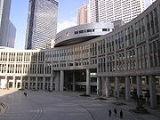
Tokyo Metropolitan Assembly
Encyclopedia

Prefectures of Japan
The prefectures of Japan are the country's 47 subnational jurisdictions: one "metropolis" , Tokyo; one "circuit" , Hokkaidō; two urban prefectures , Osaka and Kyoto; and 43 other prefectures . In Japanese, they are commonly referred to as...
parliament of Tokyo
Tokyo
, ; officially , is one of the 47 prefectures of Japan. Tokyo is the capital of Japan, the center of the Greater Tokyo Area, and the largest metropolitan area of Japan. It is the seat of the Japanese government and the Imperial Palace, and the home of the Japanese Imperial Family...
.
Its 127 members are elected every four years in 42 districts by single non-transferable vote
Single non-transferable vote
The single non-transferable vote or SNTV is an electoral system used in multi-member constituency elections.- Voting :In any election, each voter casts one vote for one candidate in a multi-candidate race for multiple offices. Posts are filled by the candidates with the most votes...
. 23 electoral districts equal the Special wards of Tokyo
Special wards of Tokyo
The are 23 municipalities that together make up the core and the most populous part of Tokyo, Japan. Together, they occupy the land that was the city of Tokyo before it was abolished in 1943. The special wards' structure was established under the Japanese Local Autonomy Law and is unique to...
, another 18 districts are made up by the cities, towns and villages in the Western part of the prefecture, one district consists of the outlying islands (Ogasawara and Izu Islands
Izu Islands
The are a group of volcanic islands stretching south and east from the Izu Peninsula of Honshū, Japan. Administratively, they form two towns and six villages; all part of Tokyo. The largest is Izu Ōshima, usually called simply Ōshima....
).
The assembly is responsible for enacting and amending prefectural ordinances, approving the budget (5.7 billion yen in fiscal 2007) and voting on important administrative appointments made by the governor including the vice governor.
Due to the special nature of the Tokyo metropolis compared to other prefectures the Tokyo Metropolitan Assembly has certain powers that would usually fall into the responsibilities of municipal parliaments. This is to ensure efficient and unified urban administration for the 23 special wards that cover the former city of Tokyo
Tokyo City
was a municipality in Japan and part of Tokyo-Fu which existed from May 1, 1889 until its merger with its prefecture on July 1, 1943. The historical boundaries of Tokyo City are now occupied by independent special wards...
and comprise the urban core of the Greater Tokyo Area
Greater Tokyo Area
The Greater Tokyo Area is a large metropolitan area in Kantō region, Japan, consisting of most of the prefectures of Chiba, Kanagawa, Saitama, and Tokyo . In Japanese, it is referred to by various terms, including the , , and others....
.
Current composition
The Tokyo prefectural election, 2009Tokyo prefectural election, 2009
Prefectural elections for the Tokyo Metropolitan Assembly were held on 12 July 2009. In the runup to the Japanese general election due by October they were seen as an important test for Taro Aso's ruling coalition of the Liberal Democratic Party and the New Komeito...
took place on July 12, 2009. As of July 2, 2010 the assembly was composed as follows:
| Composition of the Tokyo Metropolitan Assembly | |
|---|---|
| Parties | Seats |
| Democratic Party of Japan Democratic Party of Japan The is a political party in Japan founded in 1998 by the merger of several opposition parties. Its socially liberal platform is generally considered center-left in the Japanese political spectrum... |
52 |
| Liberal Democratic Party of Japan | 38 |
| New Komeito | 23 |
| Japanese Communist Party Japanese Communist Party The Japanese Communist Party is a left-wing political party in Japan.The JCP advocates the establishment of a society based on socialism, democracy and peace, and opposition to militarism... |
8 |
| Tokyo Seikatsusha Network Tokyo Seikatsusha Network The Tokyo Seikatsusha Network is a local Japanese political party affiliated with Tokyo Seikatsu Club, a consumer's cooperative. It is generally moderate left, and tends to appeal to the same voters as the Social Democratic Party of Japan and Democratic Party of Japan.-External links:*... |
3 |
| Independents (Jichi shimin '93: 1; Togikai Nippon Sōshintō Japan Innovation Party The , NST, is an upcoming Japanese political party to be formed in May 2010. The political party will be formed by present and former regional government leaders. It will be officially headed by Hiroshi Yamada, with Hiroshi Nakada assuming the post of secretary-general and former Yamagata Gov.... : 1) |
2 |
| Total (1 vacant seat) | 126 |

